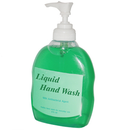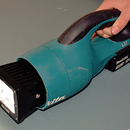Introduction: Recycled Workshop Organzier
This is a simple way of storing tools, supply's, and general clutter, and though not 100% recycled Is does use plastic which is an environmental nightmare to dispose off.
This instuctable was inspired by my most hated nemesis "cords" I hate them with a passion, always getting in-tangled, getting under my feet and in the way, and been just that little bit too short.
I need some where to store tools with these nasty attachments, as all my tools seem to have self tangling cords fitted.
Since making this storage unit the cords have behaved and it great to be able to just grab a box with a power tool in it and have all the accessorys and supply's in the same place and to be able to throw it all back in the box and not have the cord tie itself to other cords.
Step 1: Stuff You Will Need
1. plastic 20litre containers
2. 450x2400mm "white board" shelving material 2 pre drilled and 2 without holes.
3. some thin plywood for the back.
4. wood glue
5. shelf supports
6. cordless drill
7. wood screws.
8. radial arm saw (or you can get the timber pre cut )
9. jigsaw
10. staple gun
11. around 2 hours
12. optional 3 milk crates and cable ties
Step 2: Chose Your Containers
20 litre containers can be picked up from many places, the back of restaurants of is a good place to look as cooking oil and cleaning products often are sold in these containers. The best ones I found are the yellow cooking oil containers as they are a nice shape, easy to cut and have some sort of UV stabilisation as they don't crack if left out side for weeks on end.
Check what the container had stored in it as some may have something toxic in it. The photo shows one that had sodium hydroxide in it. Nasty stuff, you certainly would want to bee cutting that open, without taking some precautions. In fact I wont use a container that has something that looks toxic inside.
Step 3: Cut Containers in Half
This is pretty easy just grab a jigsaw and cut the containers in half. There is a seam that you can follow all the way around and they cut easily with a wood saw blade.
Some containers have a deep recess in the bottom and can be difficult to cut all the way around with a jig saw. I cut as far as I can go in one direction then turn the container around and start again from the other direction. Using this method I can usually get the saw to cut through the recess.
Once in half you can wipe out the oil or wash it out. You can also sand the edges, but I don't bother.
If you choose to use a container that's had chemicals in it it would pay to wash it out before you start cutting it and wear gloves and goggles.
Step 4: Making the Shelf
The drawings show the shelf frame design with one side and the back removed for clarity. You do need the centre shelf glued and screwed in place as shown for strength and it will need a back on it for the same reason. If you don't have a radial arm saw most good hard ware stores will cut the it for you if buy the timber from them you give them a drawing.
Step 5: Cutting the Timber
Australia has used the metric system since the 70s but strangely when you measure things in millimetres you can get some rather odd results so I've drawn on the board inches as well. The " white board shelving " as it called here, is sold as 450 x 2400 mm but its not that size at all. It dead on 17.5 inches by 8 feet long so that is around 446mm by 2438 mm kind of a weird measurement in a metric country but something you need to be aware of as it could lead to mistakes if your used to only using metric. You only need to cut the 2 boards without holes into several 13 inches long boards as the the containers are 12 inches across.
Then one of these 17.5 by 13 inch boards is cut into 4 equal parts the layout on the photo explains it better than my rambling.
Step 6: Make the Top Center and Base
Its pretty easy just grab three 17" .5 x 13" boards and the four 4' by 17.5 boards and make one "n" shape and two " L" Shapes using some wood glue and screw it together with a cordless drill and wood screws.
Step 7: Attach the Sides and Back
You can then attach the sides as shown with the n shape at the bottom and the 2 L shapes on in the centre and on on top. make sure you orientate the sides so the hole are around the right way and the with white strip on the front. It is simply glued and screwed on. The back can be marked out and cut to size and glued and stapled on with a large staple gun.
It is a good idea to not move the shelf for a few hours until the glue dries as it will be quite heavy and easy to break.
Step 8: Shelf Supports
Shelf supports, are just these little pins that you insert into the holes and put your shelf on top, this makes the shelves fully adjustable.
you can put in as many or a few shelves as you need an they can be remove later if you want.
Step 9: Store Your Tools
I found that most tools will fit nicely into the recycled containers, and those pesky cords are finally tamed. It also great to be able to store things like blades and grinding disc s in the same spot. you can label them and repeat, as many times as you need, I even have a few spare spaces for when the tool sales start.
Step 10: Optional Milk Crate Ladder
Sometimes its a long way to the top shelves, in your hunt for 20 litre containers you might spot some plastic milk crates. Just grab three of them and cable tie them together for a free, light weight and useful step ladder.
Step 11: Organize Your Pets
20 litre containers can be used for other things also. I use one cut in half as shown to catch the oil under the car when doing an oil change and put parts in when doing repairs. I nailed one to a tree with a large hole in the bottom, to attract nesting birds, but I got something else entirely

Participated in the
Make It Real Challenge













